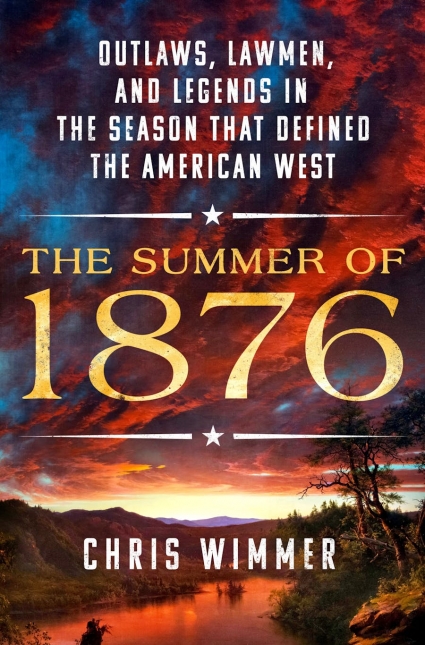The Summer of 1876: Outlaws, Lawmen, and Legends in the Season that Defined the American West
- By Chris Wimmer
- St. Martin’s Press
- 320 pp.
- Reviewed by Bob Duffy
- July 31, 2023
A fascinating rundown of the frontier’s famed good and bad guys (and girls).

The year 1876 is thronged with towering figures in the mythos of the Old West. Many of us have known these legendary folks forever — drivers of schoolyard chatter, titans of movies and the small screen, and maybe a daydream or two. In The Summer of 1876, Chris Wimmer reanimates the lot of them: Indian fighters, buffalo hunters, marshals, gunslingers, desperados, cavalrymen, bank robbers, saloonkeepers, cowgirls, and the odd actress or prostitute.
Of course, there’s a difference between free-range imaginings and faithful history. This book lies squarely in the latter category, sticking to the facts and stripping away the filmic sheen that dream-makers like John Ford and Howard Hawks so brilliantly imparted. It’s an engaging, thoroughly rewarding read on its own terms, lean as a greyhound, a swift slice to the bone of resonant truth.
The bloody defeat of George Armstrong Custer — the unintended outcome of the bluecoats’ persecution of the tribes of South Dakota and Montana — looms large in this account. Wimmer’s Custer is no Errol Flynn — no smiley paragon of gleaming insouciance — nor is he the self-absorbed poseur that some latter-day historians seem to have decided on. This author depicts him sparely, and maybe a little sparingly. Still, his Custer comes across as haughty, impulsive, and bent on harvesting glory via the savage pillage of his adversaries.
Wimmer doesn’t traffic much in historical analysis, but even so, the shameful realities leading to Little Big Horn leap out. One is General Philip Sheridan’s determination to suppress the native insurgents at any cost, including extermination. Another: the discovery of tantalizing gold deposits in the Black Hills, a sprawling expanse granted in perpetuity to the Sioux nation under an 1868 treaty. As white prospectors swarmed into South Dakota with yee-hawing alacrity, the paperwork supporting this agreement must have crumbled to dust in President Grant’s file cabinet. Writes Wimmer:
“Later estimates said that miners pulled more than a million dollars of gold out of the ground per month…Newspapers began calling the Black Hills the ‘richest 100 square miles on earth,’ and saloon operators and savvy gamblers could get rich nearly as quickly as miners who struck it lucky.”
The author’s recounting of the slow-burn, week-by-week run-up to the massacre pays off. But The Summer of 1876 is studded with other engrossing moments, too. The names of the key players are familiar: Earp, Masterson, Hickok, the James boys, Sitting Bull, Crazy Horse, Buffalo Bill Cody, Calamity Jane. Quite the crowd.
Take the fascinating, ever self-promoting Calamity Jane, born Martha Jane Canary. Looking back on her life, she declared herself, among other things, a daredevil, a professional wagoner, a teamster, an Army scout on the periphery of Custer’s last stand, and the side-piece of the married Wild Bill Hickok. Wimmer pooh-poohs each of these George Santos-level whoppers but — as if in seamy compensation — offers that Calamity was almost certainly a cross-dresser and an off-and-on prostitute. Yes, legend is a cruel mistress, but irony’s a real bitch.
Then again, a ways along on the space-time continuum in the mid-1950s, Calamity is resurrected in a mellifluous Technicolor portrayal by Doris Day. No frontier slattern, Day’s Jane does a bit of plot-serving cross-dressing early on but, heaven forfend, never works the sheets. And when the real Calamity dies, in 1903, they bury her elbow-to-elbow with Hickok. Yup, pardner, there’s that irony thing again — with a lick of lightly earned credulity, to boot.
Wimmer recounts at least one quaintly fascinating anecdote that seems to have escaped notice in the roaring cataract of celebrity legend: Wyatt Earp, while a stalwart upholder of gun-barrel justice, might well have preferred fisticuffs to more deadly violence. In the interest of preemptively safeguarding civic order, he regularly challenged and thrashed the stuffing out of Dodge City bad guys in efficient, one-on-one street fights. How did John Ford, Henry Fonda, and their screenwriters miss that nugget?
The compact The Summer of 1876, crafted with marvelous subtlety and economy, should equip you with a treasury of comparable factoids. There’s a refreshing, unadorned authenticity in Chris Wimmer’s take on the goings-on in this watershed year.
Bob Duffy reviews frequently for the Independent.

